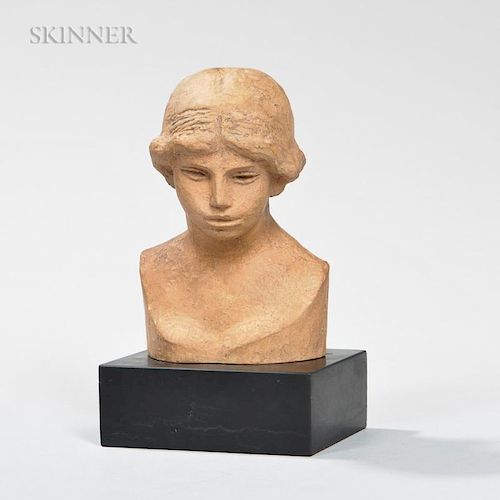Pierre-Auguste Renoir (French, 1841-1919) and Richard Guino (Spanish, 1890-1973) Tête de Vénus (Variante de la petite Vén
Lot 331
About Seller
Bonhams Skinner
274 Cedar Hill Street
Marlborough, MA 01752
United States
Founded over four decades ago, Bonhams Skinner offers more than 60 auctions annually. Bonhams Skinner auctions reach an international audience and showcase the unique, rare, and beautiful in dozens of categories, including the fine and decorative arts, jewelry, modern design, musical instruments, sc...Read more
Categories
Estimate:
$5,000 - $7,000
Absentee vs Live bid
Two ways to bid:
- Leave a max absentee bid and the platform will bid on your behalf up to your maximum bid during the live auction.
- Bid live during the auction and your bids will be submitted real-time to the auctioneer.
Bid Increments
| Price | Bid Increment |
|---|---|
| $0 | $10 |
| $100 | $25 |
| $500 | $50 |
| $1,000 | $100 |
| $3,000 | $250 |
| $5,000 | $500 |
| $10,000 | $1,000 |
| $30,000 | $2,500 |
| $50,000 | $5,000 |
| $100,000 | $10,000 |
| $300,000 | $25,000 |
| $500,000 | $50,000 |
| $1,000,000 | $100,000 |
About Auction
By Bonhams Skinner
May 11, 2018
Set Reminder
2018-05-11 14:00:00
2018-05-11 14:00:00
America/New_York
Bidsquare
Bidsquare : Fine Paintings & Sculpture
https://www.bidsquare.com/auctions/skinner/fine-paintings-sculpture-3199
Bonhams Skinner bidsquare@bonhamsskinner.com
Bonhams Skinner bidsquare@bonhamsskinner.com
- Lot Description
Pierre-Auguste Renoir (French, 1841-1919) and Richard Guino (Spanish, 1890-1973)
Tête de Vénus (Variante de la petite Vénus)
Signed "Renoir" on the back of the base.
Terra-cotta, height 5 7/8 in. (15.0 cm), on a black stone plinth.
Condition: Surface grime, pinhole to back of the head, just above the bun.
N.B. The work is accompanied by a Certificat d'Authenticité prepared and signed by Corinne Guino, wife of Michel Guino, son of the artist Richard Guino. Mme. Guino reports that this collaborative work Renoir-Guino was executed in 1913. A cast was included in the exhibition of sculpture by Renoir and Guino, organized by descendants of both artists, held in Paris at Hôtel Le Bristol in November 1974 on the occasion of the centenary of Impressionism, and it is illustrated in the catalog for the exhibition.
In his later years, with some nudging from the dealer Ambroise Vollard, Renoir began to create sculptures, but the severe crippling of his hands with arthritis made it impossible. Seeking to support the artist in this new and likely lucrative endeavor, Vollard sought a sculptor who might serve as Renoir's assistant. He found a young Catalan artist, Richard Guino, who, since 1910, had been working for Aristide Maillol, a sculptor whom Renoir admired and whom Vollard also represented. Orchestrating this new collaboration with Renoir, Vollard introduced Renoir to Guino at Maillol's studio, announcing, "I have found your hands." (1.)
Guino was much more than an assistant to Renoir; it is suggested that he was the primary creator of the sculptures. The two artists became close associates, and it was Guino's particular genius to be able to express in clay the essence of Renoir's paintings. Between 1913 and 1918, Guino worked under Renoir's direction on sculptures with the same themes as his paintings, often portraits of Renoir's friends and family or nudes. Renoir made drawings and sometimes sketches to be reproduced in three dimensions by Guino. The two artists worked in close proximity at Les Collettes, the estate at Cagnes-sur-Mer near Nice that Renoir had purchased in 1907, the painter at his easel on the first floor of the villa and the sculptor in his studio in the garden.
Anticipating the success of these sculptures, Vollard did everything he could to ensure he had exclusivity for their production and distribution in bronze, going as far as to minimize Guino's role. It took a lengthy lawsuit before Guino's contribution as joint artist was fully recognized in 1973. (2.)
1. Alix Kirsta, The Renoir Wars, The Telegraph, May 5, 2007.
https://www.telegraph.co.uk/culture/3664946/The-Renoir-wars.html accessed 3/8/2018
2. Vivien Raynor, Art: Bronze Sculptures of Renoir and Guino, The New York Times, November 2, 1984. https://www.nytimes.com/1984/11/02/arts/art-bronze-sculptures-of-renoir-and-guino.html accessed 3/8/2018
Estimate $5,000-7,000
Width at base is 9.0 cm.
Depth at base is 6.5 cm.
Depth from nose to the back of the bun is approximately 10.0 cm
The absence of a condition statement does not imply that the lot is in perfect condition or completely free from wear and tear, imperfections or the effects of aging. Condition requests can be obtained via email (lot inquiry button) or by telephone to the appropriate gallery location (Boston/617.350.5400 or Marlborough/508.970.3000). Any condition statement given, as a courtesy to a client, is only an opinion and should not be treated as a statement of fact. Skinner Inc. shall have no responsibility for any error or omission. - Shipping Info
-
Please visit http://www.skinnerinc.com/services/payment-and-shipping/ for information regarding the collection of items purchased at auction.
-
- Buyer's Premium



 EUR
EUR CAD
CAD AUD
AUD GBP
GBP MXN
MXN HKD
HKD CNY
CNY MYR
MYR SEK
SEK SGD
SGD CHF
CHF THB
THB























